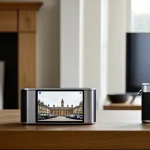Overview of Iconic UK Women’s Fashion Trends
Iconic fashion trends have the power to transcend time, leaving a distinct mark on the world of style. To be considered iconic, a trend must captivate the imagination, influence global fashion, and become a symbol of an era. It’s more than just popular clothing; it’s about a cultural resonance that molds societal standards and attitudes. In the UK, women’s clothing over the past decade has seen notable shifts, embedded in the societal narrative and historical context.
The past decade witnessed a dynamic evolution of UK women’s clothing, largely shaped by unforeseen events and cultural phenomena. Noteworthy developments emerged from the rich tapestry of British society, reflecting its eclectic blend of tradition and innovation. This era stands as a testament to cultural influences in fashion evolution, as styles adapted to reflect social movements, economic changes, and technological advancements.
Have you seen this : How do UK women stay ahead in the fashion game?
Culture and socio-political movements hugely impact these trends, guiding designers and consumers alike. For instance, the UK’s multicultural society continuously influences design aesthetics, making London Fashion Week a hub for culturally rich sartorial expressions. Ultimately, cultural influences in fashion evolution not only affect what’s seen on the runway but also redefine consumer perceptions, encouraging a more diverse and inclusive approach to fashion.
The Rise of Athleisure
In recent years, the phenomenon of athleisure has blurred the lines between gym wear and casual fashion. This trend originated from a blend of athletic and leisure styles, promoting comfort without sacrificing style. As women’s fitness fashion gained momentum, athleisure became a staple in casual wear wardrobes across the UK.
In parallel : What Influences UK Women’s Fashion Preferences Today?
Several key brands helped popularize athleisure in the UK. Nike, Adidas, and Lululemon have led the charge, offering multifunctional pieces that are both stylish and practical. These brands have seamlessly combined fashion and function, enabling women to transition from workouts to social settings effortlessly.
The impact of social media and influencers cannot be understated in the rise of athleisure. Influencers on platforms like Instagram and TikTok have showcased how versatile and chic these outfits can be, inspiring followers to adopt this trend in their daily lives. By displaying their active lifestyles, influencers have expanded athleisure into a fashion statement representing both health and relaxation.
Sustainable Fashion Movement
In the last decade, sustainable fashion has emerged as a vital force in the UK, driven by heightened environmental awareness and ethical considerations. At its core, sustainable fashion prioritizes eco-friendly clothing practices, encompassing everything from the materials sourced to production processes, minimizing the environmental footprint.
Major UK Designers and Brands
Leading the charge in sustainable fashion are ethical brands like Stella McCartney, renowned for her unwavering commitment to cruelty-free products and eco-conscious designs. Similarly, brands such as People Tree and Thought have gained acclaim for their dedication to fair trade and sustainable production practices. These designers not only promote eco-friendly clothing but also set benchmarks for responsibility within the fashion industry.
Consumer Response and Growth
The shift towards sustainable fashion has garnered significant consumer interest, spurring a notable rise in eco-conscious shopping. Shoppers are increasingly prioritizing transparency and ethical standards, seeking products that align with their values. This change in consumer behavior is contributing to an expanding market for sustainable apparel, paving the way for a more conscious and responsible fashion future.
The Return of Vintage Styles
In the ever-evolving fashion scene, vintage fashion has made a remarkable comeback. Many are drawn to nostalgic trends that evoke a sense of history and individuality. This revival is partly fueled by a longing for distinctiveness, a sharp contrast to fast fashion’s ubiquity.
Pop Culture Influence
The resurgence of retro styles is highly influenced by pop culture and media. TV shows and movies set in previous decades have rekindled interest in styles from eras gone by. This dramatised portrayal of the past makes vintage clothing appealing, transforming it from niche to mainstream.
Where to Find Vintage
Enthusiasts can explore various UK markets to find unique pieces that echo bygone eras. Notable markets include London’s Portobello Road and Brick Lane, where treasure hunters can unearth retro styles spanning diverse decades. These hubs have become essential for those seeking to curate an authentic vintage wardrobe.
Statement Accessories and Bold Prints
In recent years, statement accessories and bold prints have become quintessential elements of UK women’s fashion, transforming everyday outfits into captivating ensembles. Accessories serve as fashionable accents, with bags, jewellery, and hats leading the charge. These items, often featuring intricate designs and vibrant colours, allow individuals to express their personal style in a distinctive manner.
Statement bags, often characterized by unique shapes and embellishments, have become a staple in wardrobes, while both understated and extravagant pieces of jewellery help create focal points in an outfit. Hats, too, have seen a resurgence, offering both practicality and flair to fashion-conscious individuals.
Bold prints remain at the forefront of this trend, with florals, animal prints, and geometric designs dominating the scene. These prints infuse life into clothing, often becoming the centrepiece of an outfit. Florals evoke a sense of whimsy and femininity, whereas animal prints offer a daring and edgy aesthetic. Geometric designs provide a modern and structured appeal, suitable for both casual and formal settings.
The integration of these accessories and prints boosts overall styling, allowing for creativity and individuality. This trend underscores the fashion industry’s move towards adaptable and personalized fashion statements, enabling women to craft a wardrobe that reflects their taste and personality.
Inclusivity and Body Positivity in Fashion
In recent years, the UK fashion scene has embraced a transformative shift towards inclusivity and body positivity, reshaping industry standards and perceptions. This evolution in the fashion industry has become a pivotal movement, championing diverse sizing and celebrating all body types. As UK fashion brands and designers focus on inclusivity, they foster a more accepting and empowering environment for consumers.
Several key campaigns and brands have been instrumental in promoting body positivity. Brands such as ASOS and Marks & Spencer have expanded their size ranges, offering inclusive fashion that caters to a wider demographic, thus making fashion accessible to everyone. Influential campaigns like Dove’s “Real Beauty” and Rihanna’s Savage X Fenty have played significant roles in promoting body diversity and breaking traditional beauty norms.
The body positivity movement carries profound cultural significance, challenging societal standards and advocating for representation and self-acceptance. As fashion narratives evolve, they become a reflection of broader societal changes, encouraging individuals to embrace their uniqueness. This shift signifies more than a trend; it marks a societal transformation, paving the way for a more inclusive future in fashion.
Influence of Technology on Fashion Trends
Technology has significantly revolutionized the fashion landscape, reshaping how consumers interact with brands and products. The rise of online shopping has transformed the traditional retail experience, offering unparalleled convenience and access to global markets. This shift has encouraged brands to establish a robust digital presence, enabling consumers to explore and purchase fashion from anywhere at any time.
Another technological advancement that has changed the fashion world is wearable tech. This innovation merges functionality with style, introducing exciting possibilities for fashion enthusiasts. Items like smartwatches, fitness trackers, and tech-integrated clothing provide both aesthetic and practical benefits, demonstrating the harmonious blend of technology and fashion.
The influence of technology extends to online fashion influencers, who wield considerable power over consumer choices and trends. These influencers showcase styles on platforms like Instagram and YouTube, reaching vast audiences and promoting new styles and brands. Their impact is profound, often dictating what’s “in” and helping brands connect with digitally-savvy fashion followers.
Looking forward, future trends in fashion technology anticipate further integration with luxury fashion. As digital experiences become more immersive, expect innovations like virtual fashion shows and augmented reality shopping experiences to become mainstream. The enduring marriage of fashion and technology continues to evolve, ensuring that the industry remains dynamic and adaptive.
Influential Designers and Fashion Icons
In the vibrant tapestry of UK women’s fashion, influential designers and fashion icons play pivotal roles in shaping trends. They not only create iconic fashion trends but also embody the spirit of entire eras. These fashion creators direct the narrative of style, bringing innovation and cultural relevance to the forefront.
Key UK Designers
Several UK fashion designers stand out for their significant contributions over the past decade. Stella McCartney and Vivienne Westwood are celebrated for their pioneering work in sustainable and eco-friendly clothing, influencing global trends with their ethical brands. Alexander McQueen continues to captivate with his distinctive designs that merge tradition with avant-garde style.
Iconic Fashion Figures
The UK is home to numerous fashion icons whose signature styles have left indelible marks. Figures like Kate Moss are synonymous with the ‘boho chic’ aesthetic, while Alexa Chung’s effortless blend of modern and vintage styles regularly inspires wardrobes. These fashion trailblazers regularly set the stage for iconic trends and signify the cultural zeitgeist.
The Role of Fashion Weeks
Fashion weeks, particularly London Fashion Week, serve as crucial platforms for showcasing emerging trends. These events are not just spectacular presentations of garment artistry but act as vital conduits for introducing new designers. They enable trendsetters to display their collections, influencing not only UK women’s clothing but also global fashion narratives.
Cultural and Social Reflections in Fashion
In the ever-evolving world of fashion, cultural influences and social issues play pivotal roles in shaping trends and narratives. The UK fashion scene, especially in women’s clothing, mirrors societal changes and acts as a platform for representing diversity. By embracing multicultural influences, designers craft styles that resonate with a wider audience, making fashion a vibrant medium for social commentary.
Fashion narratives often reflect pressing social issues, serving as a powerful tool for advocacy. Topics like gender equality, racial diversity, and environmental sustainability frequently find their place on runways, highlighting fashion’s influence beyond aesthetics. Designers use their collections to make statements, encourage dialogue, and pave the way for cultural acceptance and change.
Furthermore, fashion’s role as a societal mirror extends to the representation of varied cultures and traditions within the UK. Cultural influences imbue collections with rich textures, patterns, and themes that celebrate global diversity. This not only broadens the appeal of the UK fashion industry but also promotes a vision of inclusivity and acceptance. By integrating cultural elements, fashion not only narrates a story but also fosters connections across societies.
Through these cultural and social reflections, fashion continues to be more than mere apparel. It emerges as a dynamic entity that champions social causes and celebrates the rich tapestry of human experience. By doing so, it encourages individuals to think critically, embrace diversity, and appreciate the intrinsic connection between society and style.
Lasting Legacy and Future Trends
The legacy of fashion trends leaves a deep imprint on today’s styles, impacting both the design process and consumer choices. As UK women’s fashion evolves, trends from the past decade continue to influence current aesthetics, driving innovation while maintaining cultural resonance. The cyclical nature of fashion ensures that iconic trends often re-emerge with contemporary twists.
Predictions for future trends suggest a stronger emphasis on sustainable practices and technological integration. As consumers become more environmentally conscious and tech-savvy, brands are likely to blend these elements creatively. Expect futuristic materials and augmented reality shopping experiences to define emerging styles.
The evolving landscape of UK women’s fashion remains vibrant and reflective of broader societal shifts. As designers navigate this dynamic industry, they embrace not only fashion’s transformative power but also its potential for cultural dialogue and expression. These factors collectively shape a fashion future that honours its legacy while eagerly anticipating what’s next.





